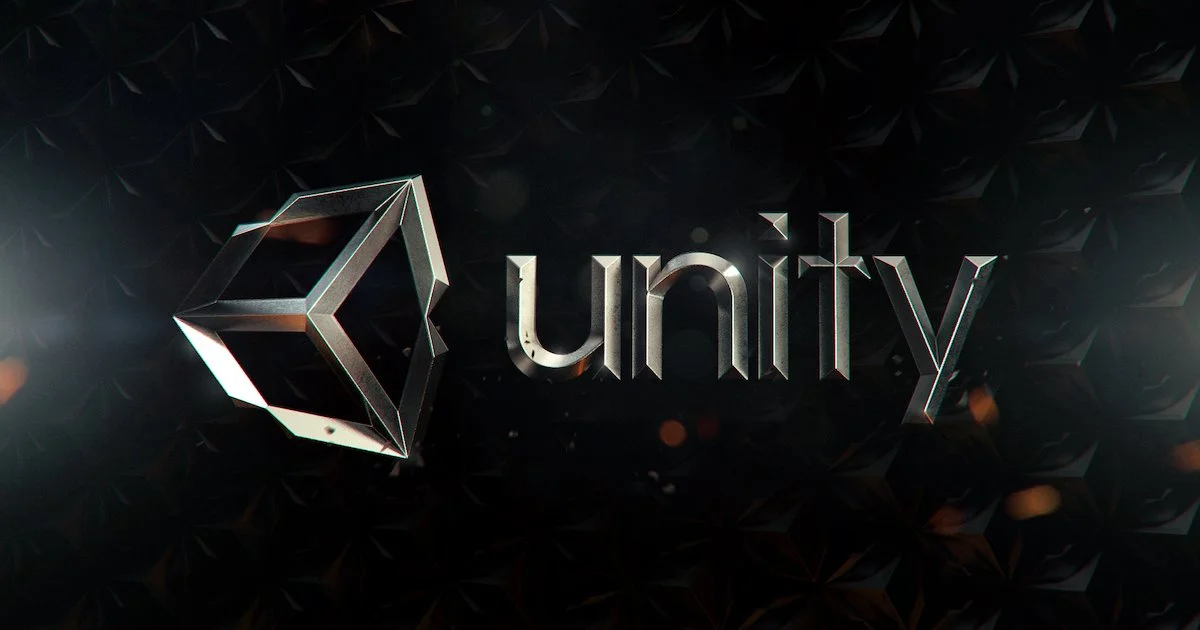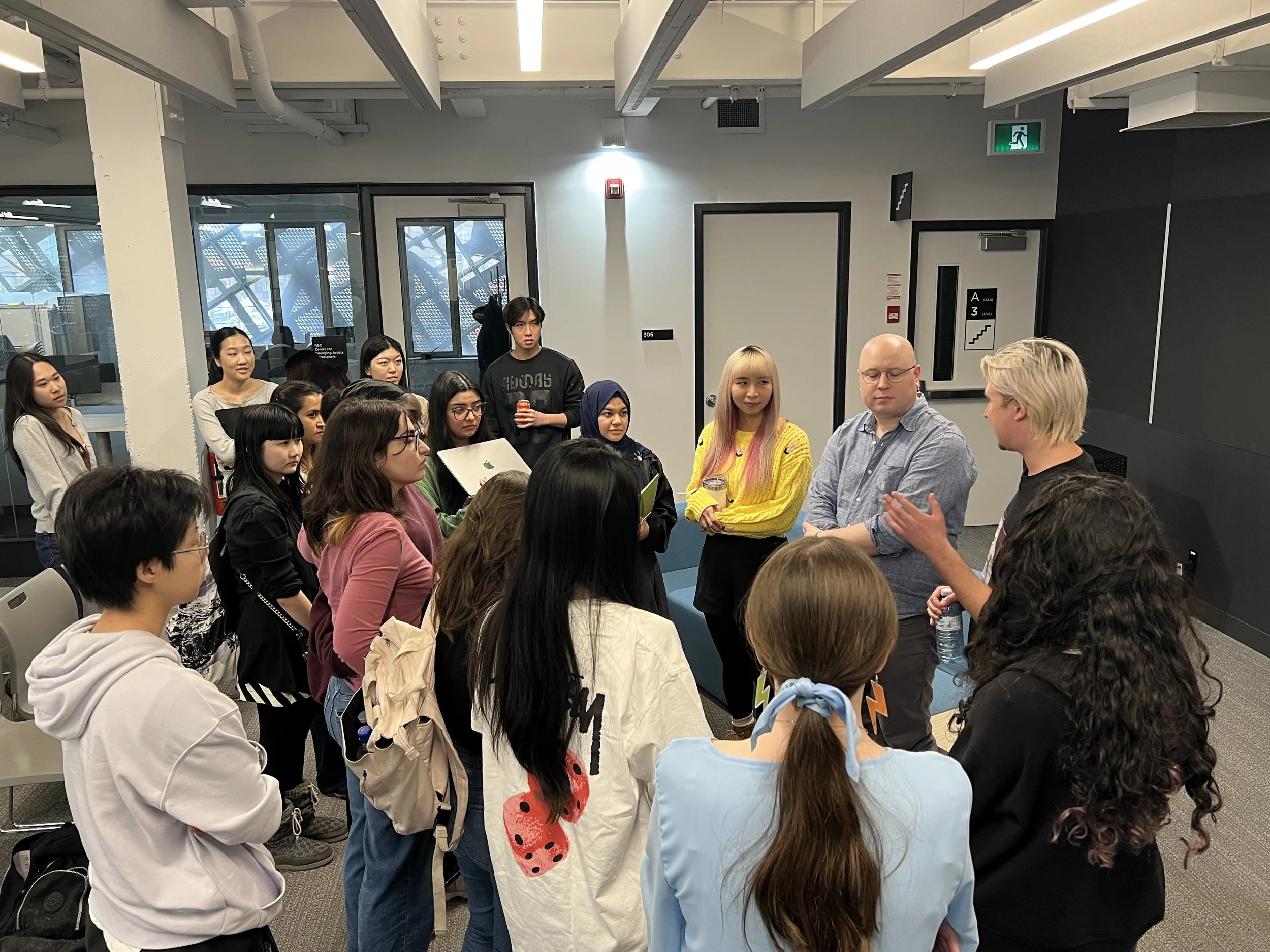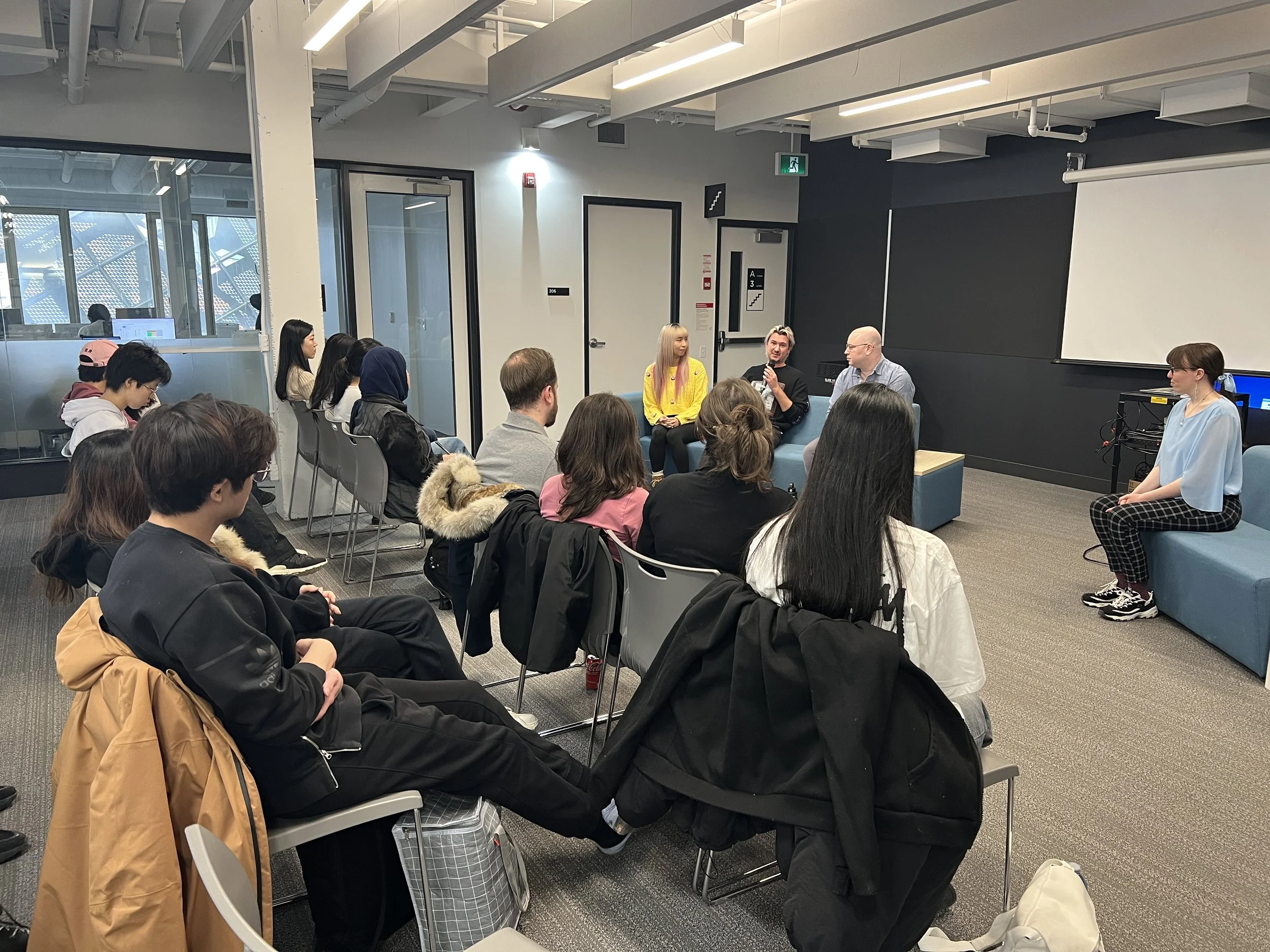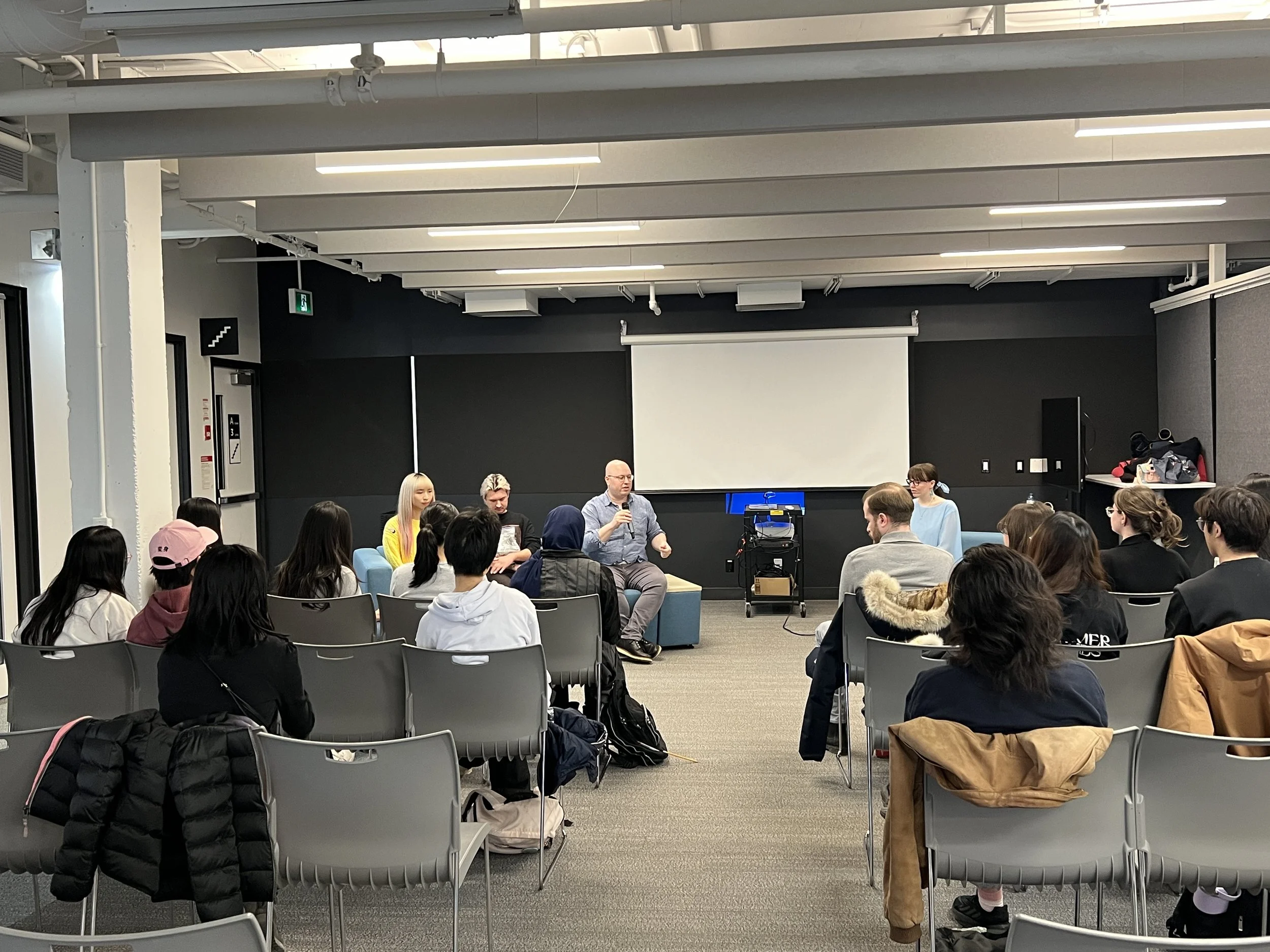
Required Reading Materials
NRIDL X Unity - Unity Game Development Bootcamp
(40 hours)
-
Short Description
This session marks the beginning of Phase 2, where students transition from browser-based vibe coding into professional game development with Unity. They learn to install and configure Unity Hub, explore the Unity interface, write their first lines of C# code, and practice importing and managing digital assets. By the end, students will have a functional Unity workspace and the foundational knowledge to begin creating their own 2D and 3D projects.
Learning Objectives
Guide students through the installation and setup of Unity Hub and the Unity Editor.
Introduce the Unity interface, including scenes, hierarchy, game objects, and assets.
Teach the basics of C# scripting for simple actions and behaviors.
Demonstrate how to import, organize, and manage assets for use in Unity projects.
Learning Outcomes
By the end of this session, students will be able to:
Install and configure Unity Hub with the correct components for 2D/3D projects.
Navigate the Unity interface and explain the role of the Scene view, Hierarchy panel, Inspector, and Project/Assets folder.
Write and attach a simple C# script to a game object, demonstrating interaction or movement.
Import images, sounds, and 3D models into Unity, organizing them into folders for clean project management.
Open, edit, and save a Unity project with confidence in their development environment.
Expanded Description
The session begins with installing and configuring Unity Hub, the gateway to Unity projects. Facilitators walk students through downloading Unity Hub, installing the correct Unity Editor version, and selecting relevant modules such as 2D, 3D, and WebGL. Students also learn how to create a new Unity project and save it in an organized folder structure, establishing habits for clean project management.
Next, students are introduced to the Unity interface. Facilitators explain the purpose of each major panel:
Scene view, where objects are placed and the game world is built.
Hierarchy, which lists all game objects currently in a scene.
Inspector, where properties of selected objects can be adjusted.
Project/Assets folder, which stores and organizes all resources for the game.
Students practice navigating between panels and manipulating simple shapes (cubes, spheres) to get comfortable with Unity’s layout.
From here, the session shifts into C# scripting basics. Facilitators explain that C# is the programming language that controls behavior in Unity, just as JavaScript controlled interactivity in Phase 1. Students write their first script — perhaps moving an object when a key is pressed — and learn how to attach it to a game object in the scene. The focus is on demystifying scripting and showing how even small snippets of code can bring projects to life.
Finally, students practice importing and managing assets. They learn to bring in images, audio, or 3D models, and organize them into folders such as “Sprites,” “Sounds,” and “Models.” Facilitators highlight the importance of clean asset management to keep projects efficient and professional.
By the end of the session, students have their first Unity project up and running. They understand how to navigate the interface, write a simple script, and integrate assets, giving them the confidence to move forward into more complex mechanics and game design.
-
Short Description
This session focuses on teaching students how to bring their Unity projects to life by designing game mechanics and using C# scripting to control them. Students build a scene by adding objects, applying physics, and making them interactive. They then take a deeper dive into C# to program player movement, user controls, and simple game states such as start, play, and game over. Finally, they practice working in teams and are introduced to the basics of version control, learning how collaboration tools help developers build games together effectively.
Learning Objectives
Teach students how to create a functional Unity scene with objects and physics.
Introduce C# scripting for player movement, controls, and game states.
Help students understand how mechanics like collisions, scoring, or win/loss conditions are implemented.
Build collaboration skills through team development and introduce version control basics.
Learning Outcomes
By the end of this session, students will be able to:
Construct a Unity scene by placing and modifying objects.
Apply physics properties such as gravity, collisions, and rigid bodies to make scenes realistic.
Write C# scripts that control movement, user inputs, and game states.
Explain how game states (menus, active play, game over) structure gameplay flow.
Collaborate in small teams and use basic version control practices to manage shared projects.
Expanded Description
The session begins with building a scene in Unity. Students add 2D or 3D objects such as platforms, characters, or obstacles, and experiment with Unity’s built-in physics system. They apply properties like gravity and collisions, observing how objects react to one another. This helps them understand the foundation of game mechanics — the rules and systems that drive gameplay.
Next, students take a deeper dive into C# scripting. Facilitators review the basics and expand into movement, user controls, and game states. Students write scripts to make a character move left or right with arrow keys, jump with the spacebar, or reset when hitting an obstacle. They also experiment with simple game states: start screens, play mode, and game over screens. This gives them a clear sense of how code structures the player’s experience.
The third component emphasizes collaborative development. Students work in small teams to extend their projects, assigning roles such as coder, designer, or tester. Facilitators introduce version control basics, explaining why developers use tools like Git to track changes and collaborate on shared projects. While the bootcamp may keep this simple, students learn how to save, commit, and share project files without overwriting one another’s work.
By the end of this session, students have created their first functional Unity game mechanics, controlled by scripts and physics. They not only understand how to build interactive scenes but also gain insight into teamwork and collaboration, which mirror the real-world practices of professional game studios. This session represents a turning point: students move from simply experimenting in Unity to building structured, playable games with intentional design.
-
Short Description
This session emphasizes refinement, testing, and iteration — essential skills for turning a working prototype into a polished, engaging game. Students learn how to enhance their projects with user interface elements, sound, and visual polish. They are also introduced to debugging strategies to troubleshoot common issues. Finally, through peer playtesting and mentor feedback, students practice the iterative process of improving their games based on real player experience.
Learning Objectives
Teach students how to refine their projects by adding user interface (UI) elements, sound, and visual polish.
Develop problem-solving skills through debugging and troubleshooting.
Provide opportunities for peer playtesting and constructive critique.
Introduce the concept of iteration — improving games step by step based on feedback.
Learning Outcomes
By the end of this session, students will be able to:
Add UI features such as menus, buttons, score displays, and health bars to their projects.
Integrate sound effects and visual effects to enhance player experience.
Identify and fix common coding and design errors in Unity.
Facilitate and participate in peer playtesting, offering constructive feedback.
Apply iterative improvement to refine and balance their games.
Expanded Description
The session begins with a focus on enhancing design. Students learn how to create and customize UI elements such as start menus, score counters, or progress bars. Facilitators explain how thoughtful UI improves accessibility and user experience, making games easier and more enjoyable to play. Students also experiment with sound integration, adding effects like jumps, collisions, or background music. Finally, they polish visuals by adjusting lighting, textures, or particle effects to give their projects a more professional look.
Next, the class turns to debugging and troubleshooting. Facilitators introduce strategies for identifying and fixing common Unity issues such as broken scripts, misplaced assets, or inconsistent physics behavior. Students are encouraged to view debugging not as a frustration but as an essential creative process — solving puzzles that make their projects stronger. They learn basic tools like the Console window and debugging logs to trace errors efficiently.
The session culminates in peer playtesting. Students share their games with classmates, who play and provide feedback on gameplay, mechanics, and enjoyment. Facilitators model constructive critique, encouraging students to focus on both strengths and areas for improvement. Mentors also circulate, offering professional insights on how to refine mechanics or design elements.
Through this process, students are introduced to the principle of iteration: games rarely succeed in their first version but become better with each cycle of feedback and refinement. Students make quick improvements based on testing, whether balancing difficulty, adjusting controls, or enhancing clarity.
By the end of the session, participants have experienced the full cycle of game development: design, build, test, and improve. They leave with games that feel more polished, engaging, and ready to showcase — while also understanding that iteration is an ongoing part of every creative project.
-
Short Description
This session equips students with the skills to share their Unity creations beyond the classroom. They learn how to export and publish their projects for different platforms, document their work as part of a digital portfolio, and explore the basics of monetization and entrepreneurship in the game and app industry. By connecting technical skills to real-world opportunities, this session helps students see their projects not just as learning exercises, but as potential stepping stones to future careers.
Learning Objectives
Teach students how to export Unity projects to formats suitable for sharing (WebGL and desktop builds).
Introduce portfolio-building skills, emphasizing documentation, presentation, and storytelling.
Expose students to entrepreneurial opportunities, including monetization pathways and platforms.
Inspire confidence by showing how their learning connects to real-world creative careers.
Learning Outcomes
By the end of this session, students will be able to:
Export their Unity projects into WebGL or desktop builds and test them on different devices.
Document their work in a digital portfolio, including screenshots, gameplay descriptions, and personal reflections.
Explain basic concepts of monetization (ads, paid downloads, in-app purchases) and identify potential publishing platforms (Steam, itch.io, app stores).
Describe entrepreneurship pathways available to indie creators and small teams.
Expanded Description
The session begins with exporting and publishing Unity projects. Facilitators walk students through the steps of building their games for WebGL (to play in a browser) and desktop applications. Students practice testing their builds on different devices to ensure functionality. Facilitators highlight how publishing allows them to share their work with friends, family, or a wider audience — a powerful motivator for young creators.
Next, students shift focus to documenting their work for a digital portfolio. They learn that a portfolio is not just a collection of files, but a curated story of their growth and creativity. Students practice taking screenshots, recording short gameplay clips, and writing descriptions that explain their design choices and coding contributions. Facilitators encourage them to reflect on what they learned, what challenges they faced, and how they solved them. These reflections strengthen self-awareness while making portfolios more compelling to future teachers, employers, or collaborators.
The session then expands into entrepreneurship and monetization basics. Facilitators introduce simple ways games generate income, such as paid downloads, ads, or in-app purchases. Students also learn about platforms where indie creators publish their work, like itch.io, Steam, and mobile app stores. Real-world stories of small teams or independent developers who turned simple ideas into successful ventures help make the concept relatable and inspiring.
Finally, the session frames these opportunities within the broader idea of creative entrepreneurship. Students are encouraged to see themselves not only as learners but as innovators capable of building projects that have impact. Whether or not they pursue monetization immediately, they understand the pathways available to them and the skills they are beginning to build.
By the end of this session, each participant has both a technically exportable game and the beginnings of a professional digital portfolio. They also leave with new awareness of how their creative coding journey could lead to future opportunities in entrepreneurship, freelancing, or the broader tech industry.
-
Short Description
The final session of the bootcamp is a celebration of achievement and a launchpad for future opportunities. Students present their browser-based and Unity games in a public showcase attended by peers, families, and invited industry guests. They receive professional portfolio reviews and constructive feedback, participate in discussions about next steps such as further education, internships, and self-publishing, and conclude with a graduation ceremony where they receive certificates of completion. This session reinforces confidence, highlights community support, and connects students to ongoing opportunities through NRIDL.
Learning Objectives
Provide students with an opportunity to present their completed projects in a professional showcase setting.
Expose participants to portfolio review and feedback from industry professionals.
Guide students in exploring next steps, including education, internships, and entrepreneurial pathways.
Celebrate student achievements and reinforce community connections to support continued growth.
Learning Outcomes
By the end of this session, students will be able to:
Present their browser and Unity games to an audience with confidence and pride.
Incorporate constructive feedback from creative tech professionals into their future portfolios.
Identify at least one possible next step in their personal journey, whether education, internship, or self-publishing.
Recognize themselves as part of a creative community supported by NRIDL and external networks.
Expanded Description
The session begins with the public showcase, where students present their games to an audience of peers, family members, and industry guests. Each participant demonstrates their browser-based project from Phase 1 and their Unity project from Phase 2, explaining their design choices, challenges, and successes. This experience builds confidence in public speaking while affirming the value of their work.
Following the showcase, invited creative tech professionals provide portfolio review and feedback. Students share their digital portfolios, which include gameplay clips, screenshots, and written reflections. Professionals highlight strengths, suggest improvements, and offer encouragement. This mentorship component gives students insight into real-world standards while validating their progress.
The session then shifts to a discussion on next steps, facilitated by mentors and NRIDL staff. Students learn about potential educational pathways (high school courses, post-secondary programs), opportunities for internships or volunteering in creative tech, and the basics of self-publishing games on platforms like itch.io or mobile app stores. The focus is on showing students that their journey does not end here — the bootcamp is a springboard into continued growth.
Finally, the session concludes with certificates and celebration. Each student is recognized for their achievement, with applause from family, peers, and mentors. Facilitators emphasize the importance of community and highlight ongoing NRIDL supports, such as mentorship, open-licensed curriculum, and networking opportunities.
By the end of Demo Day, students not only leave with projects and portfolios they are proud of but also with a sense of belonging to a larger creative ecosystem. They understand their next steps, feel celebrated for their achievements, and are connected to resources and mentors who can help them continue developing their skills and pursuing their passions.
Unity Game Development Bootcamp – FAQ
-
This Unity course is designed to introduce youth to professional game development using Unity, one of the most widely used platforms in the gaming industry. Over 40 hours of hands-on learning, students will explore how to design, script, polish, and publish their own games, while building a digital portfolio to showcase their work.
-
Learning Unity offers several advantages, particularly for those interested in game development and interactive experiences:
Accessibility and Ease of Learning:
Unity features a user-friendly interface and a vast amount of online resources, including tutorials and community forums, making it relatively accessible for beginners. You can start with visual scripting or learn C# for more advanced functionality.
Versatility in Development:
Unity supports the creation of both 2D and 3D games and applications. It can be used to develop for a wide range of platforms, including mobile, desktop, consoles, VR/AR, and web, allowing for broad reach.
Industry Relevance and Job Opportunities:
Unity is a widely used engine in the game development industry, especially among indie studios and for mobile game development. Proficiency in Unity can open doors to various job opportunities in game development and related fields.
Strong Foundation in Game Development Principles:
Learning Unity provides a solid understanding of fundamental game development concepts, including coding principles, game engine functionality, and design best practices, which are transferable to other engines if needed.
-
The Unity program runs for 40 hours, spread across 4 weeks of instruction (Phase 2) plus one showcase week (Phase 3). Each week includes structured lessons, project work, and peer collaboration.
-
Students will cover the following topics:
Phase 1: Unity Studio Foundations
Session 1: Installing Unity Hub, navigating the Unity interface, C# scripting basics, importing assets.
Session 2: Building a game scene, applying physics and interactivity, scripting player controls, team collaboration, and version control.
Session 3: Polishing with UI, sound, and visual design; debugging common issues; playtesting with peers and mentors.
Session 4: Exporting games for desktop and web, building digital portfolios, and learning basics of monetization and entrepreneurship.
Phase 2: Showcase & Industry Engagement
Session 5: Demo Day where students present their projects to peers, families, and industry guests; receive professional portfolio feedback; explore future pathways such as internships, education, and self-publishing; and celebrate with certificates of completion.
-
By the end of the course, students will be able to:
Install and configure Unity and create their own 2D/3D projects.
Build interactive game scenes with objects, physics, and controls.
Write and apply C# scripts for movement, game states, and interactivity.
Debug, polish, and test their games for an improved player experience.
Export projects for WebGL and desktop, making them shareable with others.
Document their work in a professional digital portfolio.
Understand pathways for monetization and entrepreneurship in the gaming industry.
Present their finished games in a public showcase.
-
This course is ideal for youth with basic coding exposure or strong interest in game development who want to learn Unity in a structured, supportive environment. Beginners are welcome — no prior Unity experience is required.
-
Access to Unity-ready workstations (if needed).
Loaner equipment (where available).
Office hours for extra help.
Guidance from mentors and feedback from creative tech professionals.
Transit support and snacks during in-person sessions.
-
A laptop capable of running Unity (if available; otherwise, workstations will be provided).
Enthusiasm, creativity, and readiness to collaborate with peers.
-
Graduates are encouraged to continue building their portfolios and may explore pathways such as:
Applying for internships or volunteer opportunities in creative tech.
Pursuing further education in coding, game design, or digital arts.
Publishing their own games on platforms like itch.io or mobile app stores.
Staying connected with NRIDL for ongoing mentorship and opportunities.
Further Development
Past Professional Network Events - Blur Studio/Full Circle Studio/Ubisoft
Program Facilitators

















